Title: Oualata - Fixing the pump
Dates: 12th–15th Nov GPS:
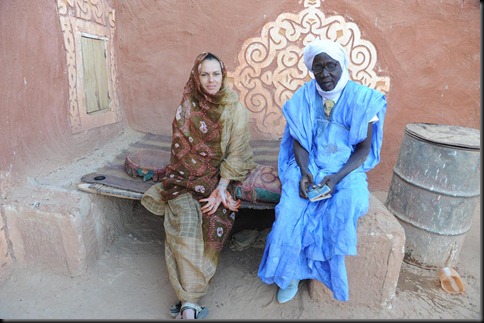
We decided to drive the 120km to Oualata rather than cycle so we could spend more quality time there. Accompanied by an armed escort provided by the governor, the first two thirds or so of the track was similar to the Nioro road – quite cycleable. The last 30-40km was a different story – deep sand but not really any defined sand ridges. John was able to show off his driving skills as the Land Rover worked overtime through the sand pit. It certainly gave a sense of isolation. Oualata is so isolated that in Mauritania, being sent to the prison here is the equivalent to being sent to Siberia in Soviet times. Being surrounded by desert and hundreds of kilometres from anywhere, there is no escape. The first president of Mauritania, Moctar Ould Daddah, often referred to as the father of the nation and who led the country to independence from France in 1960, was toppled in 1978 in a military coup and sent to Oualata, incarcerated as a political prisoner. Since then there have been ten coups, each overthrowing a democratically elected government and a number of leaders have been sent to Oualata. The old town is nestled in the side of a rocky breakaway, the steep incline forming a natural terracing. By law all buildings in Oualata must be designed and constructed in the traditional way, with stones and ochre-brown coloured clay or dung rendering. The ruins of the old town (approximately 600 years old) sit the highest. In fact, the original town buried deep beneath the valley floor, was built in the 11th Century. Our journey ended at the mayor’s office, high up on the hillside. Here we were greeted as official guests by the deputy mayor and other commune officials. We stayed in their guest house and were treated with seemingly constant flow of communal meals and Mauritanian tea.
Oualata exists due to its position at the western end of a major Saharan trade route. Salt was the main material traded. The caravans would bring salt to a site a few kilometres from the town and then it was processed in Oualata. These salt caravans still exist constantly travelling the 300 or so kilometres from Timbuktu which is directly east. We have been fortunate to see two of these caravans as they arrive for their pit stop; unload, water their camels, reload and set off. Those who work the route today are descendants of families who worked centuries ago. The business is kept in the family. Many other products were also traded; materials, kola nuts, metals, slaves, food, spices, religious manuscripts and educational texts. The level of education in Oualata back in the eleventh century (before Timbuktu) was more advanced than in Europe. The deputy mayor, Baba is directly de scended from one of the four original families of Oualata. His ancestors migrated across the Sahara from Iraq, bringing their education with them. Our other hosts have similar stories; Cidina (cultural advisor and maths teacher) and Cidi Ould Merzong (general secretary of the commune and history and civic education teacher). Cidina showed us 600 year old books from his family library.
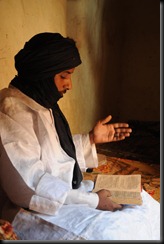 The tradition of education still exists today, although times are changing. Seyid took me to visit the Chaike (leader/traditional teacher) of the Mahadrass (Traditional school of the desert). He is in charge of teaching traditional subjects such as Islamic law, religion, languages, literature, old civilisation (Greek, Roman), history. He recited some verses only now read in Oualata and Andalucía, Spain for us. This learning process is for all stages of life from childhood to old age, the idea being that learning must be a continual process. In this culture people are encouraged to learn as it shows dignity and constant study is considered desirable. The Chaike understands the need for both his teachings and modern learning through the local primary and secondary schools. His clients are diminishing and so he needs to adapt to keep learning relevant and the community alive. Dan mentioned that as he wandered through the streets on our first day he was surprised to meet a couple of young kids – one spoke Russian, the other Spanish. Many kids are learning English and French with the hope that this will bring them opportunities away from Oualata. A whole generation is draining away from the community and with this trend the future of the town fades. The Chaike encourages the younger generation to at least try to visit their town on holidays rather than disappear forever.
The tradition of education still exists today, although times are changing. Seyid took me to visit the Chaike (leader/traditional teacher) of the Mahadrass (Traditional school of the desert). He is in charge of teaching traditional subjects such as Islamic law, religion, languages, literature, old civilisation (Greek, Roman), history. He recited some verses only now read in Oualata and Andalucía, Spain for us. This learning process is for all stages of life from childhood to old age, the idea being that learning must be a continual process. In this culture people are encouraged to learn as it shows dignity and constant study is considered desirable. The Chaike understands the need for both his teachings and modern learning through the local primary and secondary schools. His clients are diminishing and so he needs to adapt to keep learning relevant and the community alive. Dan mentioned that as he wandered through the streets on our first day he was surprised to meet a couple of young kids – one spoke Russian, the other Spanish. Many kids are learning English and French with the hope that this will bring them opportunities away from Oualata. A whole generation is draining away from the community and with this trend the future of the town fades. The Chaike encourages the younger generation to at least try to visit their town on holidays rather than disappear forever.
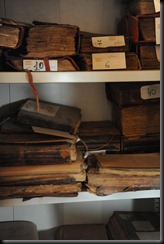 One of the main reasons I wanted to visit Oualata was to visit the library, designated by UNESCO as a World Heritage Site as a place which must be conserved for its cultural importance. The library is actually the private family collection of the Abderrahman family. The daughter being the only family member left alive, Afe Mint Abderrahman is in charge of the 1077 documents covering a broad range of subjects. While its international significance has been recognised, the cost of repairing, maintaining, and preserving the documents, some up to 600 years old, is far beyond the means of the family or the commune. Expertise in cataloguing, creating micro fiches, facsimiles, and preserving the library building is not available either. The only help has come from a Spanish NGO, Monde 3, and that ended a few years ago. This is a big, much specialised job and help is urgently required. I believe a proper management plan needs to be created first, which would be an initial appraisal, budget and plan to involve people of Oualata – those who will take ownership and care for their treasure.
One of the main reasons I wanted to visit Oualata was to visit the library, designated by UNESCO as a World Heritage Site as a place which must be conserved for its cultural importance. The library is actually the private family collection of the Abderrahman family. The daughter being the only family member left alive, Afe Mint Abderrahman is in charge of the 1077 documents covering a broad range of subjects. While its international significance has been recognised, the cost of repairing, maintaining, and preserving the documents, some up to 600 years old, is far beyond the means of the family or the commune. Expertise in cataloguing, creating micro fiches, facsimiles, and preserving the library building is not available either. The only help has come from a Spanish NGO, Monde 3, and that ended a few years ago. This is a big, much specialised job and help is urgently required. I believe a proper management plan needs to be created first, which would be an initial appraisal, budget and plan to involve people of Oualata – those who will take ownership and care for their treasure.
Over the generations people of Oualata have developed their own culture. In ancient times the culture was known as the Azaire culture and civilisation. They were a combination of Arab, African and Berbera – I guess this makes sense considering its importance as a focal point of Saharan trade. They had their own language. Some words which are still used will only be understood by descendants of the Azaire culture. There are also local food specialities and drinks.
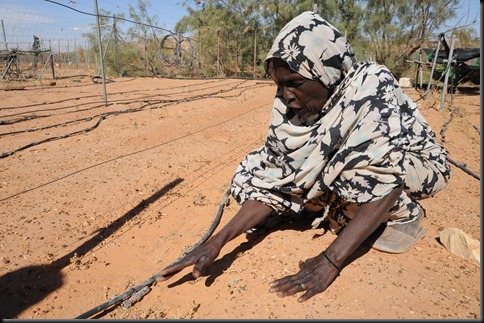
I became inspired to visit Oualata a few years ago after reading a photo-story in the Geographical Magazine. A project which particularly interested me was the Women’s Farming Project, an initiative set up by a cooperation between the Mauritanian and Spanish governments. I was impressed to see photos of women from 60 of the poorest families in the town working in a newly created market garden – locally referred to as the Oualata “Garden of Eden”. Each woman was given her own plot which she took ownership of, growing vegetables from seedlings in the nursery for her family. Any excess were traded for extra income. The women were happy, empowered by a sense of purpose. I was impressed by the lushness, date palms and other fruit trees. There were solar cells and a generator to drive the water pump. It looked like a paradise in the desert. So I was shocked to see that everything was dead, bone dry and the women out of work. Why? No water. Why? The pump is broken. Why can’t you fix the pump, it’s just a simple part missing? I couldn’t really get a direct answer other than they couldn’t get any help. I didn’t understand because these are well-educated people, leaders of the town. It was only after our tour when I spoke to Seyid who had been doing some detective work to find out the real story.
The project was set up in 1994 and run for 10 years by the joint government venture. The objectives were:
- Preserve the library, protect the manuscripts (this part of the project received two years of support)
- Women’s Farming Project – develop the project described. (received eight years of support)
- Improve health facilities (no support)
- Development of local grazing farming (no support)
In total roughly 6 million Euros were pumped into this programme.
Monde 3 took over the market gardening project, adding some tourist chalets as an extra form of income and contributed to some building and library restoration for the next two years. In 2007 the Mauritanian government reclaimed responsibility under their National Institution for Protection of Old Cities of Mauritania (Ministry of Culture).
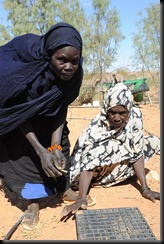 What Seyid found out however explains what went wrong. Alongside the project, people were being given hand outs of food parcels and other basics every two weeks. This created a culture of dependency. Secondly, all skilled jobs were given to foreign hired help from Spain and Morocco (for example). There was no skill transfer, no education about management of such a project, so that when a relatively minor problem occurs such as the pump breaking down, the whole system fails – no water, no industry. I am saddened by this – a classic example of development aid in the 80’s and early 90’s. Hand outs don’t work anywhere. “Fixing the pump” in this case requires far more than attending to a minor mechanical failure. That’s just the short term emergency. All the women have the basic skills to produce the food. Even though these people are products of a culture with centuries of learning tradition, there is a desperate need to empower with managerial, operational and organisational skills. Their isolation is an issue but in modern times this can be overcome. Poverty is a problem, funds being required to restart the project, but this has to be made sustainable. From the information I have been presented, I think a possible sustainable solution could come from a partnership between an agricultural college or university and the Oualata commune. I know it is not that simple and it would require much negotiation and time to rebuild trust in foreigners offering help. I have been reminded that many have promised much to Oualata and not delivered. There is a general feeling that organisations have intervened in the past to make themselves look good in the short term rather than empowering the people of Oualata with the tools they need to sustain their way of life.
What Seyid found out however explains what went wrong. Alongside the project, people were being given hand outs of food parcels and other basics every two weeks. This created a culture of dependency. Secondly, all skilled jobs were given to foreign hired help from Spain and Morocco (for example). There was no skill transfer, no education about management of such a project, so that when a relatively minor problem occurs such as the pump breaking down, the whole system fails – no water, no industry. I am saddened by this – a classic example of development aid in the 80’s and early 90’s. Hand outs don’t work anywhere. “Fixing the pump” in this case requires far more than attending to a minor mechanical failure. That’s just the short term emergency. All the women have the basic skills to produce the food. Even though these people are products of a culture with centuries of learning tradition, there is a desperate need to empower with managerial, operational and organisational skills. Their isolation is an issue but in modern times this can be overcome. Poverty is a problem, funds being required to restart the project, but this has to be made sustainable. From the information I have been presented, I think a possible sustainable solution could come from a partnership between an agricultural college or university and the Oualata commune. I know it is not that simple and it would require much negotiation and time to rebuild trust in foreigners offering help. I have been reminded that many have promised much to Oualata and not delivered. There is a general feeling that organisations have intervened in the past to make themselves look good in the short term rather than empowering the people of Oualata with the tools they need to sustain their way of life.
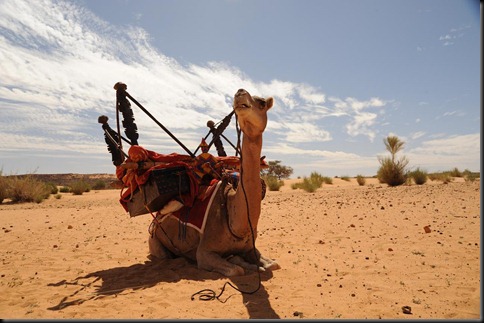
I was shown a few other bright lights, small businesses looking for connections but not sure how to go about it. The tourist season is fairly short here – essentially the winter – December, January, February. With bandits infiltrating occasionally across the Algerian border, the police are vigilant with security to protect visitors and the local economy. This doesn’t help the tourist industry – it just takes one negative press report and that’s enough to stop many intrepid travellers. We stayed in a great auberge on the last two nights run by Ba o Bechir Gamny (+222 711 32 530) and there are four more. The service was amazing and his food the best we have had in Africa so far. I also met with Fatimetou Zahra Moulaye Ely president of the Women’s cooperative for the restoration of the Oualata murals and Handicrafts (loosely translated) (+222 445 67 23). Traditional artwork which is such a feature of the architecture of Oualata is done a special style of finger painting done by the women. They also make all sorts of handicrafts and beautiful cloth which they sell during the tourist season and to traders who visit the town. There would be a great opportunity for trade via internet (I’m sure not far away).
There is so much here that three days isn’t enough time to take everything in. We will move on tomorrow after visiting the salt caravans, our next stop Segou, Mali. Please be aware that this is only what I’ve learned while I am here and what Seyid has translated.
(Editor’s note: Don’t forget to visit Kate’s Diary to read about her other recent adventures, including her trek from Mali to Mauritania.)



{ 7 comments… read them below or add one }
Kate,
You make Mauritania a fascinating place to visit thanks for so much detail it is the best read for me ,what you are sending is realtime not even news .you know what that mean,bit like following true theatre .
Cheers Mike
Kate, thanks for sharing everything you are experiencing. Your experiences enable us to learn so much. Keep smiling, Dina & Geoff
Hi kate
Good to read that things are going well
Your stories are fascinating and in part relate to some of the issues that we face in this counctry with our indiginoues population.
Good luck John
Good to see your progress. Very interesting blogs and beautiful stills. I hope it’s also captured on video for the documentary. I just sent a Twitter message to all my contacts. Hopefully they will look at your website and follow your amazing adventure.
Best regards,
Claudio von Planta
Hey Kate,
I was just wondering how long did it take you to get through Chad?
Did you run into any trouble on the way through there?
Anyway, good luck on the rest of the way type you later
Mitchell t
GO KATE!!!!!!!
Hi Kate,
I’m in grade 6 at Barwon Heads Primary School and we are closely following your progress and I think what your doing is really great!
Anyway just a few questions for you,
To train for something like this, such as going through the sand, do you ride your bike on the beach???
Is this something you have always wanted to do??
Good Luck Kate what your doing is great and you should be really proud of yourself. All of us here at BHPS really admire you.
Annabelle =)
Keep it up, have fun and remember to smile.
Hi Kate,
I am in Grade 6 at Barwon Heads primary school and we are following your progress on your website. I have a few questions for you and it would be great if you could answer them. How did you train for all the conditions? Did you go to the beach or to the mountains or anything? Is this ride a test for you or not? I think you are really strong for doing this. GO KATE!!!!
From Jakara